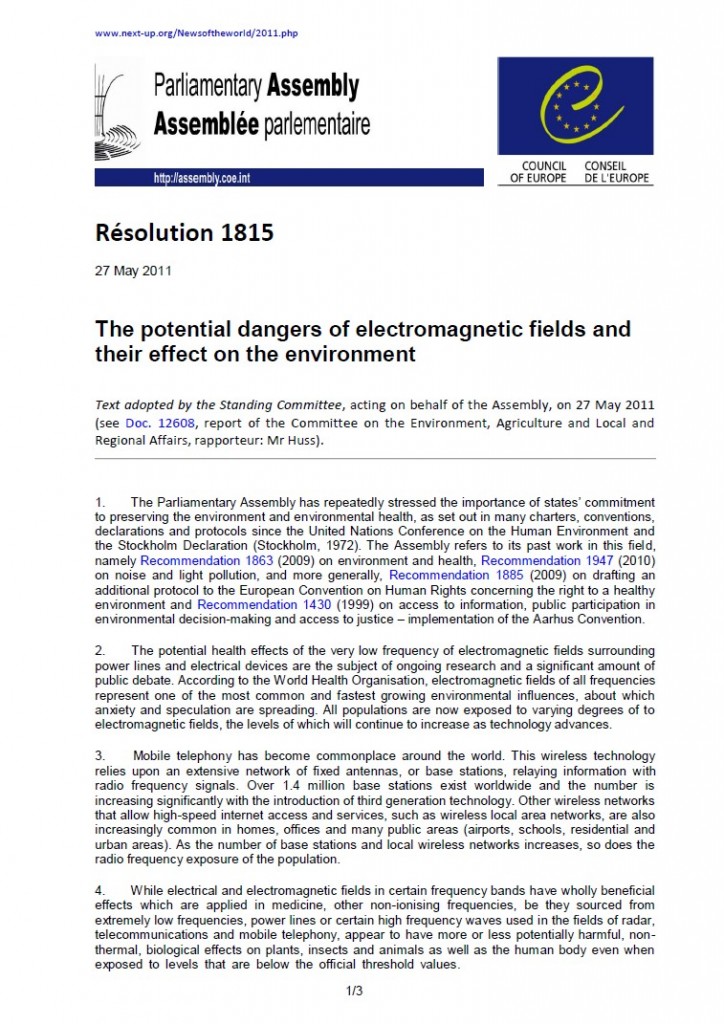Portada del sitio > Prensa > CANADÁ: New study warns of risks from emissions, suggests towers be kept (...)
CANADÁ: New study warns of risks from emissions, suggests towers be kept away from homes
Viernes 26 de noviembre de 2010 · 2280 lecturas
New study warns of risks from emissions, suggests towers be kept away from homes
By Tom Spears, The Ottawa CitizenNovember 5, 2010
The above map shows cellphone towers and tower clusters in the Ottawa area. Such structures should be kept 450 metres from peoples’ homes as they may lead to symptoms such as nausea, depression, headaches, poor sleep and skin issues, says a study in the NRC Press journal Environmental Reviews.
Photograph by: Dennis Leung, The Ottawa Citizen, The Ottawa CitizenOTTAWA - Just as Ontario announces that cellphones don’t need danger labels, the National Research Council Press publishes research saying we’re awash in radiation from cellphone towers and it does have the potential to hurt us.
And it says Wi-Fi and Wi-Max transmissions and smart grids are worrisome too, even though all these sources use relatively low power. Cell towers use a few hundred watts, while commercial radio uses tens of thousands.
But today’s study says it’s too late to turn back the clock, and all we can hope for is to keep towers far from people whenever possible. There are about 350 cell towers, or transmitters mounted on tall buildings, in Ottawa and Gatineau. Carriers keep the exact number secret.
"Radiofrequency radiation is a form of energetic air pollution and it should be controlled as such," says the study in the NRC Press’s journal Environmental Reviews. It’s published online today.
It suggests that cell towers should be kept 450 metres from peoples’ homes, and made nearly 50 metres tall.
And it says the arrival of wireless technology such as Wi-Max — which carries Internet signals to a wide area — increases people’s exposure to radiation, and makes precautions more difficult.
It says symptoms can include:
![]() Nausea and visual disruptions in people living within 10 metres of a cellphone tower.
Nausea and visual disruptions in people living within 10 metres of a cellphone tower.
![]() Irritability, depression and memory loss between 10 and 100 metres.
Irritability, depression and memory loss between 10 and 100 metres.
![]() Headaches, poor sleep and skin problems between 100 and 200 metres.
Headaches, poor sleep and skin problems between 100 and 200 metres.
The location of new towers has repeatedly upset Ottawa residents.
This year, when a tower popped up without warning 15 metres from his lot line, David Oikle complained to City Hall.
He didn’t get far. City officials said they have no authority to move the tower, because Industry Canada is in charge. But Industry Canada told Oikle the city can in fact demand some accommodation from cellphone tower builders.
"We should have put it somewhere else," said Oikle. "I’m 48 years old. I’ve lived in Ottawa all my life, with the technology we’re exposed to every day. Who knows what the effects are?
"From a health perspective, it (the tower) is over there. I don’t know what it does to me ... I’m a finance guy. I don’t have any particular knowledge" about health effects.
The new study adds to a wide body of research, some suggesting potential harm from cellphone transmissions, others arguing it’s safe.
The Canadian Wireless Telecommunications Association says cellular transmissions in Toronto — with the country’s biggest concentrations of towers — are less than one-seventh of one per cent of Health Canada’s maximum safe level.
Bioengineering professor Henry Lai of the University of Washington and medical writer Blake Levitt went back through 50 years of research for the study published today, and discovered an intriguing fact: Today’s radio waves are "remarkably similar" to the steady irradiation of the U.S. Embassy in Moscow prior to 1976 by the Soviets. Effects on Americans stationed there have been studied in the long term.
Four main symptoms emerged from the Moscow personnel: eczema, psoriasis, allergic reactions, and inflammatory reactions. As well, there were reports of neurological problems, including mood changes and depression, difficult pregnancies and births, and tumours (malignant in women but benign in men.)
"Such reports of adverse effects on well-being are occurring worldwide near cell infrastructure and this does not appear to be related to emotional perception of risk," the study says.
Yet "obsolete" government standards protect only against short-term exposure to strong blasts of radiation, not long-term effects from low levels, the researchers conclude.
"In considering public health, we should concentrate on aggregate exposures from multiple sources" of the radiation they say, and not on each cellphone tower in isolation.
As well, health authorities must add in the extra radio waves coming from Wi-Fi and smart grid systems. "Only in that way will low-level electromagnetic energy exposure be understood as the broad environmental factor it is."
While an estimated 5.1 billion people use cellphones today, the study suggests we don’t know how much exposure people experience. For instance, it says, one building may filter out 100 times more radiation than another, depending on their materials. And people on the second floor of a building may be exposed more than those on the ground floor.
A proper health study would compare people exposed to these radio waves with people who aren’t exposed, the authors note. Just one catch: It’s almost impossible to find a place with no cellphone signals.
� Copyright (c) The Ottawa Citizen
Ver la noticia original AQUÍ
VER EL ESTUDIO COMPLETO EN PDF







